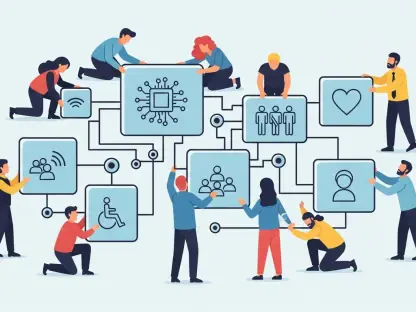I’m thrilled to sit down with Laurent Giraid, a renowned technologist whose expertise in artificial intelligence spans machine learning, natural language processing, and the critical ethical considerations of AI deployment. With a deep understanding of how AI is reshaping industries like healthcare, Laurent offers unique insights into the challenges and opportunities of evaluating AI systems beyond traditional metrics. In this interview, we explore the transformative potential of AI in real-world applications, the limitations of current evaluation methods, the risks of over-reliance on benchmarks, and the future of holistic assessment frameworks.
How has AI, particularly advanced systems like the latest models, influenced problem-solving in critical fields such as healthcare?
AI is fundamentally changing the landscape in fields like healthcare by offering tools that can analyze vast amounts of data at unprecedented speeds. For instance, in diagnostics, AI models can now assist in detecting conditions like cancer from imaging scans with accuracy rivaling, and sometimes surpassing, human experts. This not only speeds up the process but also helps reduce human error, potentially saving lives. Beyond diagnostics, AI is also streamlining administrative tasks, like managing patient records, which frees up clinicians to focus on care. However, the real impact lies in personalized medicine—AI can analyze genetic data to tailor treatments to individual patients, which is a game-changer for effectiveness.
What do you see as the main advantages of using benchmark tests to evaluate AI performance?
Benchmarks provide a standardized way to measure AI capabilities, which is incredibly useful for developers and companies to compare systems and track progress. They offer a clear, quantifiable metric—whether it’s accuracy, speed, or relevance of outputs—that can be communicated easily to stakeholders or investors. For example, scoring high on a benchmark in software coding can demonstrate a model’s potential to automate complex tasks, which builds confidence in the technology. They also create a common ground for the AI community to push innovation by setting targets to beat.
Why do you think there’s often a disconnect between benchmark results and real-world AI performance?
The gap exists because benchmarks are typically designed in controlled, idealized settings that don’t account for the messy, unpredictable nature of real life. They focus on narrow tasks or datasets that may not reflect the diversity of challenges an AI faces when deployed. For instance, a healthcare AI might ace a medical licensing exam benchmark but struggle with the nuances of patient interaction or rare, undocumented cases in a hospital setting. Context is everything—real-world variables like user behavior, cultural differences, or environmental factors can drastically alter outcomes, and benchmarks often overlook those.
There have been concerns about companies manipulating benchmark results to inflate perceptions of their AI models. How prevalent do you think this issue is, and what impact does it have on trust in AI?
I believe this issue is more common than we’d like to admit, especially in a competitive industry where high benchmark scores can attract massive funding or market share. When companies tweak models or datasets to optimize for specific tests, it undermines the integrity of the evaluation process. This erodes trust not just among developers and researchers but also with the public, who may start questioning whether AI promises are genuine or just marketing hype. Trust is critical, especially in sensitive areas like healthcare, where overblown claims could lead to misplaced reliance on flawed systems.
The concept of Goodhart’s Law suggests that when a measure becomes a target, it loses its value as a measure. How does this apply to the current focus on AI benchmarks?
Goodhart’s Law is incredibly relevant to AI evaluation. When benchmarks become the primary goal, developers might prioritize optimizing for those specific tests over building systems that are robust in diverse, real-world scenarios. This can result in AI that looks impressive on paper but fails when faced with practical challenges. It’s a short-term win at the expense of long-term reliability. The obsession with benchmark scores can also stifle innovation by narrowing focus to what’s measurable rather than what’s truly impactful.
New evaluation frameworks, such as those designed for healthcare AI, aim to provide a more comprehensive assessment beyond traditional benchmarks. What are your thoughts on these holistic approaches?
I’m very optimistic about holistic frameworks because they attempt to capture the complexity of real-world applications. In healthcare, for example, these frameworks evaluate AI across a range of tasks—like clinical decision-making, communication, and even ethical considerations—which is far more reflective of actual practice than a single test score. They push us to think about AI as part of a larger ecosystem, not just a standalone tool. However, they’re still evolving, and we need to ensure they account for human-AI interaction and broader societal impacts, which remain underexplored.
Looking ahead, what is your forecast for the future of AI evaluation methods and their role in ensuring safe and effective systems?
I believe we’re on the cusp of a major shift toward a more integrated evaluation ecosystem that combines rigorous testing with real-world feedback. Methods like red-teaming and field testing will become standard, allowing us to see how AI behaves under stress or in unpredictable environments. We’ll also likely see greater collaboration between academia, industry, and civil society to develop transparent, reproducible standards. My hope is that within the next decade, we’ll have a measurement science for AI that prioritizes safety, equity, and societal benefit over mere performance metrics. It’s a challenging road, but essential if AI is to deliver on its transformative potential without unintended harm.









